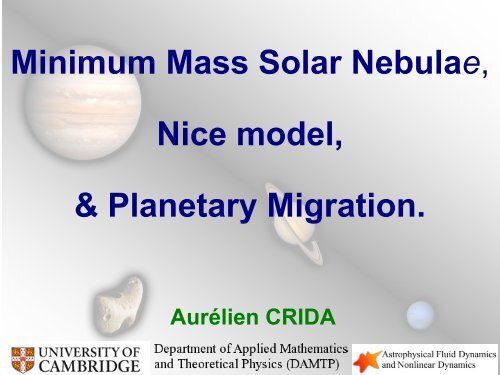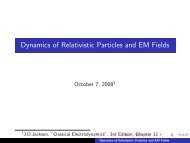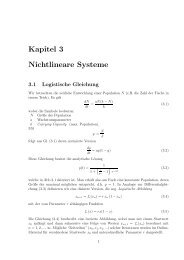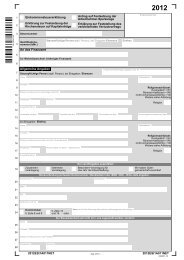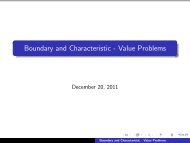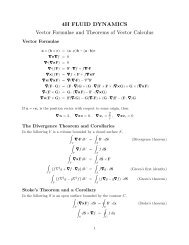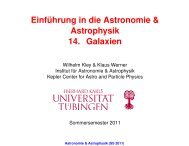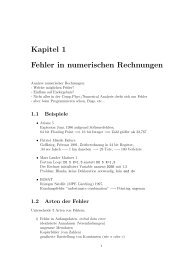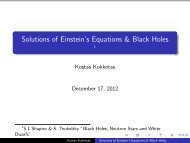Minimum Mass Solar Nebulae and Planetary Migration
Minimum Mass Solar Nebulae and Planetary Migration
Minimum Mass Solar Nebulae and Planetary Migration
You also want an ePaper? Increase the reach of your titles
YUMPU automatically turns print PDFs into web optimized ePapers that Google loves.
<strong>Minimum</strong> <strong>Mass</strong> <strong>Solar</strong> <strong>Nebulae</strong>,<br />
Nice model,<br />
& <strong>Planetary</strong> <strong>Migration</strong>.<br />
Aurélien CRIDA
1) MMSN : definition, recipe<br />
<strong>Minimum</strong> <strong>Mass</strong> <strong>Solar</strong> Nebula<br />
Little reminder :<br />
It is not a nebula,<br />
but a protoplanetary disc.<br />
<strong>Solar</strong> : from which the <strong>Solar</strong> System is born.<br />
<strong>Minimum</strong> <strong>Mass</strong> :<br />
just enough solid material to build the 8 planets.<br />
Importance :<br />
Density used in basically all processes of planet formation.<br />
A. Crida Tübingen, 5/3/2009
1) MMSN : definition, recipe<br />
Recipe of the <strong>Minimum</strong> <strong>Mass</strong> <strong>Solar</strong> Nebula<br />
Ingredients for 8 planets :<br />
~ 60 Earth masses of solids (chondritic composition).<br />
~ 0.01 solar mass of the famous mixture H (75%), He (25%).<br />
Preparation :<br />
Spread the appropriate mass of solids around the orbit of each planet.<br />
Multiply the obtained density by 100 (add gas).<br />
Cover with a power law profile.<br />
Dispose around the Sun for 10 million years.<br />
You get the <strong>Solar</strong> System. Enjoy !<br />
A. Crida Tübingen, 5/3/2009
1) MMSN : definition, recipe<br />
Weidenschilling (1977), Hayashi (1981) :<br />
1.5<br />
Σ ( r ) = 1700 ⎜ ⎟ g.cm -2<br />
⎛<br />
⎝<br />
r<br />
1AU<br />
⎞<br />
⎠<br />
−<br />
Main assumptions :<br />
The planets accreted all the solids (therefore «minimum»).<br />
They formed where they presently orbit.<br />
... did they ?<br />
A. Crida<br />
Tübingen, 5/3/2009
2) The Nice model<br />
After the protoplanetary disc dispersal, the giant planets<br />
were on circular orbits, in a compact configuration,<br />
surrounded by a disc of planetesimals.<br />
(Gomes et al. 2005 ; Tsiganis et al, 2005)<br />
Planetesimal scattering perturbs<br />
the orbits of the planets.<br />
When Jupiter <strong>and</strong> Saturn reach<br />
their 2:1 resonance,<br />
the system is destabilized :<br />
→ Late Heavy Bombardement.<br />
→ The planets reach their<br />
present orbits.<br />
A. Crida Tübingen, 5/3/2009
2) The Nice model<br />
The Nice model explains :<br />
The eccentricities of the giants<br />
the Late Heavy Bombardement.<br />
Time [years]<br />
A. Crida<br />
Tübingen, 5/3/2009
2) The Nice model<br />
The Nice model explains :<br />
The eccentricities of the giants<br />
the Late Heavy Bombardement.<br />
And also :<br />
✔<br />
The capture of Jupiter's<br />
Trojans on inclined orbits<br />
(Morbidelli et al, 2005).<br />
✔<br />
The Hildas <strong>and</strong> D-type<br />
asteroids (Bottke et al, 08).<br />
✔<br />
The capture of the irregular<br />
satellites by the giants<br />
(Nesvorny et al, 2007).<br />
✔<br />
The Kuiper Belt architecture<br />
(Levison et al, 2007).<br />
A. Crida<br />
Tübingen, 5/3/2009
3) Return of the MMSN<br />
If the Nice model holds, the giant planets didn't<br />
form where they now orbit.<br />
After the gas disc phase, they were located at :<br />
Jupiter : 5,45 AU ;<br />
Saturn : ~8,2 AU ;<br />
Neptune: 11-12 AU ;<br />
Uranus: 14-17 AU.<br />
Then, the Hayashi density profile is out of date.<br />
Desch applied the recipe with these positions<br />
(<strong>and</strong> improved the cooking).<br />
A. Crida<br />
Tübingen, 5/3/2009
3) Return of the MMSN<br />
Desch (2007) : a MMSN based on the Nice model<br />
- Compact configuration,<br />
- Uranus ↔ Neptune,<br />
- Disc of planetesimals,<br />
→ Excellent fit with :<br />
⎛ r ⎞<br />
Σ(r) = 50500 g.cm -2<br />
1AU<br />
10 times more dense at 5 AU<br />
than Hayashi's MMSN.<br />
Much steeper slope.<br />
⎜<br />
⎝<br />
⎟<br />
⎠<br />
−<br />
2.168<br />
A. Crida<br />
Tübingen, 5/3/2009
<strong>Migration</strong>, did you say migration ?<br />
The orbital radius may change through 3 different processes :<br />
●<br />
Small size bodies (
4) <strong>Migration</strong> strikes back<br />
Jupiter, Saturn, Neptune & Uranus in Desch (2007) disc.<br />
100 Jupiter orbits on a fixed orbit, then released.<br />
Jupiter: runaway,<br />
type III migration,<br />
lost.<br />
Saturn : type I,<br />
then type III<br />
migration, lost.<br />
Neptune :<br />
type I, lost.<br />
Uranus :<br />
type I, lost.<br />
Uranus<br />
Neptune<br />
Saturn<br />
Jupiter<br />
A. Crida Tübingen, 5/3/2009
4) <strong>Migration</strong> strikes back<br />
Jupiter, Saturn, Neptune & Uranus in Desch (2007) disc.<br />
Non localy isothermal EOS: viscous heating, radiative cooling.<br />
Jupiter: runaway,<br />
type III migration,<br />
lost.<br />
Saturn, Neptune,<br />
Uranus, lost.<br />
The planets can't<br />
survive more<br />
than 20 000 yrs.<br />
( Crida, 2009,<br />
ApJ, submitted)<br />
semi major axis [AU]<br />
14<br />
12<br />
10<br />
8<br />
6<br />
4<br />
2<br />
0<br />
0<br />
Neptune<br />
Saturn<br />
Jupiter<br />
2000<br />
Uranus<br />
This is the case<br />
for any disc,<br />
insn't it ?<br />
time [years]<br />
16000<br />
A. Crida<br />
Tübingen, 5/3/2009
4) <strong>Migration</strong> strikes back<br />
Jupiter & Saturn in Hayashi (1981) density profile,<br />
with same H/r, α as in Desch (2007), localy isothermal EOS.<br />
10<br />
No type III,<br />
no runaway.<br />
Jupiter, Saturn<br />
enter in 3:2<br />
mean motion<br />
resonance,<br />
semi major axis [AU]<br />
9<br />
8<br />
7<br />
6<br />
5<br />
Saturn<br />
Jupiter<br />
<strong>and</strong> stop !<br />
4<br />
0<br />
10 4<br />
time [years]<br />
3.5x10 4<br />
A. Crida<br />
Tübingen, 5/3/2009
4) <strong>Migration</strong> strikes back<br />
Jupiter, Saturn, Neptune & Uranus in Hayashi (1981) disc.<br />
On longer term, with other disc parameters :<br />
Jupiter-Saturn:<br />
in resonance,<br />
stop.<br />
Neptune,Uranus,<br />
also caught in<br />
resonance, after<br />
type I migration.<br />
( Crida, 2009,<br />
ApJ, submitted)<br />
semi major axis [AU]<br />
30<br />
25<br />
20<br />
15<br />
10<br />
5<br />
0<br />
0<br />
Neptune<br />
Uranus<br />
Saturn<br />
Jupiter<br />
10 4<br />
<strong>Mass</strong>et & Snellgrove (2001)<br />
Morbidelli & Crida (2007)<br />
time [years]<br />
10 5<br />
A. Crida<br />
Tübingen, 5/3/2009
5) A new hope<br />
Morbidelli et al. (2007) :<br />
6 possible resonant configurations<br />
in the gas disc.<br />
2 are stable over 10 8-9 yrs<br />
without gas disc.<br />
With a planetesimals disc,<br />
a (late) global instability<br />
can take place.<br />
This is the « Nice model II ».<br />
A. Crida Tübingen, 5/3/2009
CONCLUSION<br />
Neither the st<strong>and</strong>ard MMSN (Hayashi, 1981), nor the newer<br />
one (Desch, 2007), are consistent with planetary migration.<br />
In a very dense disc, the giants<br />
can't survive (runaway migration<br />
of Jupiter <strong>and</strong> Saturn, no resonance).<br />
Formation of the giant planets<br />
over a wide radial range, in a low density disc,<br />
then, migration, approach, <strong>and</strong> resonances,<br />
then, Nice model II.<br />
Radial drift <strong>and</strong> migration make<br />
the recipe of the MMSN irrelevant.<br />
A. Crida<br />
Tübingen, 5/3/2009


